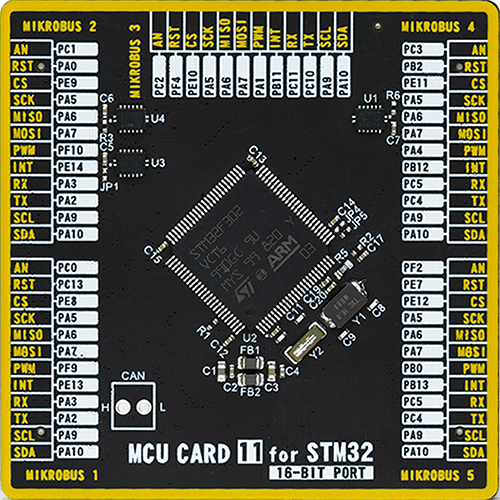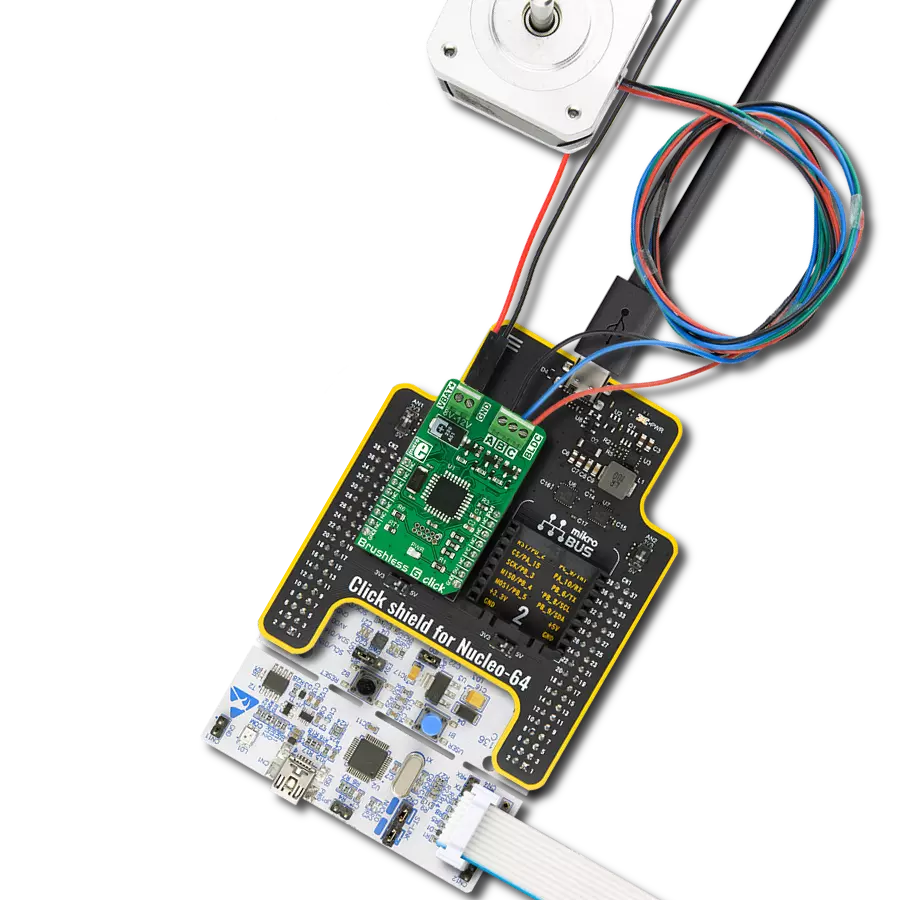Our versatile brushless motor control solution seamlessly integrates into existing systems, providing a powerful and adaptable solution for diverse engineering needs
A
A
Hardware Overview
How does it work?
Brushless 15 Click is based on the TB9061AFNG, an automotive pre-driver with a sensorless controller for driving a 3-phase full-wave brushless DC motor from Toshiba Semiconductor. A 3-phase motor is driven by the PWM output signals, with the duty cycle determined by the PWM signal from mikroBUS. This input PWM signal is measured, calculated, and corrected in the logic circuit. The TB9061AFNG generates a 20kHz internal PWM signal according to its result. After that, the TB9061AFNG inputs internal PWM into the Sensorless Core Logic and outputs a sensorless driving signal for a 3-phase brushless motor. In addition to the PWM signal, the internal PWM duty cycle can also be controlled using an analog voltage applied to the ASIG pin of the TB9061AFNG, set manually using an onboard trimmer labeled as VR1. Analog voltage from the VR1 controls the internal PWM duty cycle when the PWM pin is shorted to the ground. The user can also select a forced commutation frequency by choosing the input voltage via an onboard rotary switch labeled SW1. Using an SW1, the TB9061AFNG receives the voltage at the SFCF
(forced commutation frequency select) pin through the internal ADC and decides the force commutation frequency from 9.375 to 25.000rpm. The user can also set a lead angle value at 7.5, 15, or 30° according to the setting of the SW2 switch. When SW2 is in a lower position, a lead angle is set to 7.5°, the upper position represents a lead angle of 15° set, and the middle position matches a lead angle 30°. If 7.5 or 15° is selected, the lead angle is set to 0° during the forced commutation. When the normal commutation starts, it is changed automatically to the value specified by the SW2. If 30° is selected, the lead angle is set to 30 ° even during the forced commutation. The TB9061AFNG features several diagnostic circuits and drive control functions, including over-current detection and a motor drive current limiter circuit, over-temperature (internal and external), and over-voltage detection. Motor lock detection, step-out detection, and automatic return control circuits are also incorporated. Alongside the PWM pin from the mikroBUS™ socket, used to drive a 3-phase motor, this Click board™ also has the Enable pin labeled as EN and routed to the CS pin
of the mikroBUS™ socket to optimize power consumption used for power ON/OFF purposes (performs Start and Stop controls of the motor operation). The DIR pin, routed on the RST pin of the mikroBUS™ socket, is used to select the direction of motor rotation (clockwise/counterclockwise). Besides, it is possible to detect a rotation speed and irregular operations, such as motor lock-up, where such a condition is indicated using the blue LED indicator labeled OUTFG routed on the INT pin of the mikroBUS™ socket. This Click board™ supports an external power supply for the motor, which can be connected to the input terminal labeled as VM and should be within the range of 6V to 18V, while the BLDC motor coils can be connected to the terminals labeled as U, V, and W. This Click board™ can be operated only with a 5V logic voltage level. Therefore, the board must perform appropriate logic voltage level conversion before using MCUs with different logic levels. Also, this Click board™ comes equipped with a library containing functions and an example code that can be used, as a reference, for further development.
Features overview
Development board
UNI-DS v8 is a development board specially designed for the needs of rapid development of embedded applications. It supports a wide range of microcontrollers, such as different STM32, Kinetis, TIVA, CEC, MSP, PIC, dsPIC, PIC32, and AVR MCUs regardless of their number of pins, and a broad set of unique functions, such as the first-ever embedded debugger/programmer over WiFi. The development board is well organized and designed so that the end-user has all the necessary elements, such as switches, buttons, indicators, connectors, and others, in one place. Thanks to innovative manufacturing technology, UNI-DS v8 provides a fluid and immersive working experience, allowing access anywhere and under any
circumstances at any time. Each part of the UNI-DS v8 development board contains the components necessary for the most efficient operation of the same board. An advanced integrated CODEGRIP programmer/debugger module offers many valuable programming/debugging options, including support for JTAG, SWD, and SWO Trace (Single Wire Output)), and seamless integration with the Mikroe software environment. Besides, it also includes a clean and regulated power supply module for the development board. It can use a wide range of external power sources, including a battery, an external 12V power supply, and a power source via the USB Type-C (USB-C) connector. Communication options such as USB-UART, USB
HOST/DEVICE, CAN (on the MCU card, if supported), and Ethernet is also included. In addition, it also has the well-established mikroBUS™ standard, a standardized socket for the MCU card (SiBRAIN standard), and two display options for the TFT board line of products and character-based LCD. UNI-DS v8 is an integral part of the Mikroe ecosystem for rapid development. Natively supported by Mikroe software tools, it covers many aspects of prototyping and development thanks to a considerable number of different Click boards™ (over a thousand boards), the number of which is growing every day.
Microcontroller Overview
MCU Card / MCU

Type
8th Generation
Architecture
ARM Cortex-M4
MCU Memory (KB)
256
Silicon Vendor
STMicroelectronics
Pin count
100
RAM (Bytes)
40960
You complete me!
Accessories
2207V-2500kV BLDC Motor is an outrunner brushless DC motor with a kV rating of 2500 and an M5 shaft diameter. It is an excellent solution for fulfilling many functions initially performed by brushed DC motors or in RC drones, racing cars, and much more.
Used MCU Pins
mikroBUS™ mapper
Take a closer look
Click board™ Schematic

Step by step
Project assembly
Track your results in real time
Application Output
1. Application Output - In Debug mode, the 'Application Output' window enables real-time data monitoring, offering direct insight into execution results. Ensure proper data display by configuring the environment correctly using the provided tutorial.

2. UART Terminal - Use the UART Terminal to monitor data transmission via a USB to UART converter, allowing direct communication between the Click board™ and your development system. Configure the baud rate and other serial settings according to your project's requirements to ensure proper functionality. For step-by-step setup instructions, refer to the provided tutorial.

3. Plot Output - The Plot feature offers a powerful way to visualize real-time sensor data, enabling trend analysis, debugging, and comparison of multiple data points. To set it up correctly, follow the provided tutorial, which includes a step-by-step example of using the Plot feature to display Click board™ readings. To use the Plot feature in your code, use the function: plot(*insert_graph_name*, variable_name);. This is a general format, and it is up to the user to replace 'insert_graph_name' with the actual graph name and 'variable_name' with the parameter to be displayed.

Software Support
Library Description
This library contains API for Brushless 15 Click driver.
Key functions:
brushless15_set_duty_cycle- This function sets the PWM duty cycle in percentages ( Range[ 0..1 ] ).brushless15_enable_device- This function enables the device by setting the EN pin to low logic state.brushless15_switch_direction- This function switches the direction by toggling the DIR pin state.
Open Source
Code example
The complete application code and a ready-to-use project are available through the NECTO Studio Package Manager for direct installation in the NECTO Studio. The application code can also be found on the MIKROE GitHub account.
/*!
* @file main.c
* @brief Brushless15 Click example
*
* # Description
* This example demonstrates the use of the Brushless 15 Click board by driving the
* motor in both directions at different speeds.
*
* The demo application is composed of two sections :
*
* ## Application Init
* Initializes the driver and performs the Click default configuration.
*
* ## Application Task
* Controls the motor speed by changing the PWM duty cycle once per second.
* The duty cycle ranges from 20% to 80%. At the minimal speed, the motor switches direction.
* Each step will be logged on the USB UART where you can track the program flow.
*
* @note
* The maximal PWM Clock frequency for this Click board is 1 kHz.
* So, depending on the selected setup the user will need to lower the MCU's main clock frequency
* in the setup in order to get the PWM clock frequency down to 1 kHz.
*
* @author Stefan Filipovic
*
*/
#include "board.h"
#include "log.h"
#include "brushless15.h"
static brushless15_t brushless15;
static log_t logger;
void application_init ( void )
{
log_cfg_t log_cfg; /**< Logger config object. */
brushless15_cfg_t brushless15_cfg; /**< Click config object. */
/**
* Logger initialization.
* Default baud rate: 115200
* Default log level: LOG_LEVEL_DEBUG
* @note If USB_UART_RX and USB_UART_TX
* are defined as HAL_PIN_NC, you will
* need to define them manually for log to work.
* See @b LOG_MAP_USB_UART macro definition for detailed explanation.
*/
LOG_MAP_USB_UART( log_cfg );
log_init( &logger, &log_cfg );
log_info( &logger, " Application Init " );
// Click initialization.
brushless15_cfg_setup( &brushless15_cfg );
BRUSHLESS15_MAP_MIKROBUS( brushless15_cfg, MIKROBUS_1 );
if ( PWM_ERROR == brushless15_init( &brushless15, &brushless15_cfg ) )
{
log_error( &logger, " Communication init." );
for ( ; ; );
}
if ( BRUSHLESS15_ERROR == brushless15_default_cfg ( &brushless15 ) )
{
log_error( &logger, " Default configuration." );
for ( ; ; );
}
log_info( &logger, " Application Task " );
}
void application_task ( void )
{
static int8_t duty_cnt = 2;
static int8_t duty_inc = 1;
float duty = duty_cnt / 10.0;
brushless15_set_duty_cycle ( &brushless15, duty );
log_printf( &logger, "> Duty: %d%%\r\n", ( uint16_t )( duty_cnt * 10 ) );
Delay_ms ( 1000 );
duty_cnt += duty_inc;
if ( 8 == duty_cnt )
{
duty_inc = -1;
}
else if ( 1 == duty_cnt )
{
duty_inc = 1;
duty_cnt = 2;
log_printf( &logger, " Switch direction\r\n\n" );
brushless15_switch_direction ( &brushless15 );
}
}
int main ( void )
{
/* Do not remove this line or clock might not be set correctly. */
#ifdef PREINIT_SUPPORTED
preinit();
#endif
application_init( );
for ( ; ; )
{
application_task( );
}
return 0;
}
// ------------------------------------------------------------------------ END


































